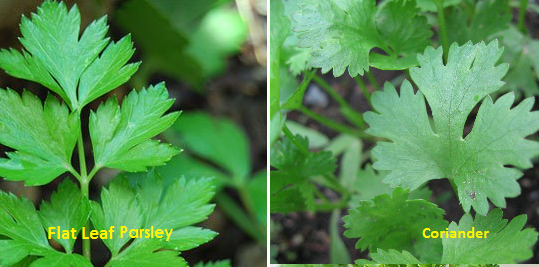Difference Between Parsley and Coriander
Table of Contents
Parsley vs Coriander
Two very essential herbs in the culinary world, parsley and coriander both belong to the Apaceae family. They are both commonly used for cooking and garnishing purposes and resemble each other to a certain extent with regards to appearance as well as taste. However, differences become evident at close inspection as well as in their usage in cooking.
What is Parsley?
A member of the Apiaceae family, parsley, scientifically known as Petroselinum crispum is commonly used as a herb, a spice and a vegetable. Widely employed in Middle Eastern, American and European cooking, parsley is a bright green plant that grows as a biennial plant in temperate climates and as an annual plant in tropical and subtropical areas. Forming a rosette of tripinnate leaves 10–25 cm long with 1–3 cm leaflets, parsley also grows a flowering stem about 75 cm tall.
Divided into two cultivar groups such as leaf parsley and root parsley, leaf parsley is once again divided into two types as curly leaf parsley and flat leaf parsley. Used as a garnish on various dishes, leaf parsley is used more as a flavour enhancer in dishes such as boiled or mashed potatoes, soups, rice dishes as well as steaks and stews. Root parsley, more specifically the hamburg root parsley, is grown as a root vegetable and is a popular ingredient in central and eastern European cuisine. Used in soups and stews, root parsley can also be eaten raw as a snack.
What is Coriander?
Coriander, scientifically known as Coriandrum sativum, and also known as cilantro, Chinese parsley or dhania, is an annual plant that is native to regions spanning from Southern Europe and North Africa to south western Asia. Both the coriander seed and the leaves are believed to possess medicinal properties and are used in various types of cuisine as well as in a variety of medicines. Coriander is a commonly used ingredient in middle eastern, Indian, Caucasian, Mediterranean, Portuguese, African, South Asian, Southeast Asian, Middle Eastern, Caucasian, Central Asian, Mediterranean, Latin American, Chinese, and Scandinavian cuisine and is used as a flavour enhancer or as a herb. The fresh leaves are quite pungent and have a strong flavour with citrus overtones that impart a distinct flavour to dishes. However, the fresh leaves are used in profusion in many Indian dishes, chutneys and salads as well as in Thai, Chinese and Mexican cuisine. As heat diminishes its flavour, it is best to serve the coriander leaves fresh or added immediately before serving.
What is the difference between Coriander and Parsley?
• Coriander is an annual plant. Parsley is an annual plant in tropical and subtropical areas and is a biennial plant in temperate regions.
• All parts of the coriander, leaves, root, stems and seeds are used in cooking. Only the parsley leaf is used for garnishing and cooking purposes.
• Comparatively, coriander is more pungent and intensely flavoured than parsley which features a mild, grassy flavour.
• Although the flat leaf parsley looks very similar to coriander, coriander features a much deeper green whereas parsley is more bright green in colour.
• Curly leaf parsley leaves are more rounded whereas coriander leaves have sharper serrations. However, when compared with flat leaf parsley, coriander leaves are more rounded in shape.
• Coriander is native to South western Asia, Southern Europe as well as North Africa. Parsley is mostly used in Middle Eastern, European and American cooking.
• Coriander is more commonly used in Middle Eastern, Asian, Indian and Latin American cuisine. Parsley is more popular amongst European and North American cuisine.
ncG1vNJzZmivp6x7pbXFn5yrnZ6YsqOx07CcnqZemLyue8OinZ%2Bdopq7pLGMm5ytr5Wau268wKuqpZ2pYq6vsIyvqmabn6e2orrDnqlmal8%3D
